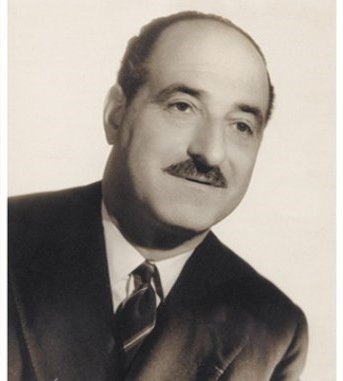
BACRI Brothers (EN)
The Bacri family was an established family of merchants, jewelers and antiques dealers, living in Paris since 1860. In 1940, the Bacri brothers were forced to leave Paris for the Côte d’Azur, then for North Africa. Their collections were seized in 1942.
Highly esteemed antiques dealers
The ancestors of the Bacri brothers had made their fortune in North Africa, as rich grains merchants or as bankers of the dey of Alger. In the 1860s, they moved to Paris, where Jacob Bacri and his brothers, Samuel, David, Joseph, Salomon and Adolphe became merchants, jewelers and antiques dealers.
The two elder sons of Jacob Bacri, Martin (his real name Mardochée, born 5 October 18681) and Léon Jules (born 11 July 18732) bought their father and uncle’s business on 22 July 1895.3 Their third brother, Vidal (Chalabée, born 1 September 18774) joined them on 31 August 1904. The enterprise “Martin & Jules Bacri” thus became “Bacri Frères.” The fourth brother, Henri (Aaron, born 13 May 18805) also joined them on 1 March 1911. Founded on the rue de Rivoli, the enterprise changed address several times: from 1, rue de Richelieu, probably beginning in 1877, year of Vidal’s birth, then to 28, rue La Boétie, surely as of 1905, year of the birth of Esther Stella, one of Leon Jules’ daughters, and finally, 141 boulevard Haussmann, where Léon Jules, his wife Clotilde and son Jacques are identified in the census in 1931.
Before the Occupation, the family’s reputation was solidly anchored in Paris. Napoleon III had been among the clients of the Bacri firm, in addition to a number of national and foreign museums: the Naïade (nymph) painted by Lucas Cranach the elder, had belonged to the Bacri family and was exhibited in the Bremen Kunsthalle, and a Portrait d’un homme, attributed to Corneille de Lyon, is conserved today in the Metropolitan Museum of New York. Medieval works having belonged to the Bacri brothers are in French museums, such as the tapestry Scènes de la Vie de la Vierge in the Cluny museum and the Pleurant statue in the Rodin Museum. The Bacri enterprise also took part in most of the exhibitions of ancient art in France and abroad as well as in other artistic events, such as the exhibition Bronzes et ivoires royaux du Benin (Royal bronze and ivory objects from Benin) organized in the Trocadero Ethnographic museum from 15 June–15 July 1932.6
Collections looted by Angerer for Göring
On 11 June 1940, the Bacri brothers hastily left Paris for Cusset,1 a commune near Vichy in the Allier department. They entrusted the keys to their building to Auguste Clocher, concierge of 140 boulevard Haussmann.2 There were twenty-five rooms in the building, housing objects of all kinds – medieval and Renaissance tapestries, wood carvings, ceramics, paintings and sculptures – the whole of the Bacri brothers’ business inventory, but also their personal collections.
Before even naming a temporary administrator to manage the firm, four removals were carried out by Josef Angerer, art dealer for Reichsmarschall Göring. On 1 July 1940, Angerer, accompanied by commissioners Lienard, Chain and Dumez, took the keys to the building from Clocher and forbid him to enter it. The latter witnessed the looting of objects, carted away in trucks, none of it estimated at the time. On 8 July 1940, Angerer returned to the building, this time accompanied by the engraver Jacques Beltrand, professor at the Beaux-Arts, who estimated the value of the objects carried off by the occupying authorities. The two returned together on 4 August 1940, then a second time during the same month.3 Bruno Lohse confirmed that part of the Bacri collection, including La Vierge à l’Enfant, painted by an imitator of Rogier van der Weyden,4 as well as a small 17th c. woven Persian panel,5 was sent directly to Göring, without passing through the Einsatzstab Reichsleiter Rosenberg (ERR).6 In 1942, the Bacri and Kramer collections were transferred to the Kögl château, the same year the Nikolsburg and Buxheim dépôts came into service.7
It is certain that later on, other merchandise was carried off by the Germans, since eighty-eight works not on Angerer’s list were passed on to the Jeu de Paume between 15–18 August 1942, inventoried by doctors Eggemann, Fleischer and Borchers.8
Liquidation of Bacri Frères and occupation of its premises
On 31 October 1940, the president of the Tribunal de commerce de la Seine (Seine department commercial court) named Léon Pioton (born 26 January 1896 in Saint-Parize-le-Châtel, in the Nièvre department), by decision filed in the Registry, temporary administrator of the firm Bacri Frères, assisted by Victor Charbonnier. A second decision of 26 November 1940 named him liquidator of the enterprise.1 However, Pioton was never able to exercise his authority: on 9 April 1941, militants from the Rassemblement national populaire (RNP), the party of Marcel Déat, illegally occupied the Bacri building. Militants from the Mouvement social révolutionnaire (MSR), another collaborationist party close to the RNP, also looted the Bacri collection.
The MSR, a competitor of the Parti populaire français (PPF), was founded in 1940 by Eugène Deloncle (1890–1944). A former member of the Comité secret d’action révolutionnaire (CSAR), better known as the “Cagoule,” Deloncle, pursuing his political actions of the 1930s, founded a party supporting the maréchal Pétain. In February 1941, the MSR merged with the RNP, created by Marcel Déat (1894–1955), political ally of Pierre Laval. During the night of 2–3 October 1941, the MSR organized seven attacks on several Parisian synagogues.2
Most of the merchandise looted from the Bacri enterprise was carried off between the time of the inventory made by the auctioneer Maurice Michaud with the expert M. Préau (26 April 1941 to 21 May 1941 at the request of Pioton) and the inventory made 20 November 1942 to 11 January 1943, demanded by Roger Noël (born 12 July 1904 in Paris, 12th arrondissement), named to replace Pioton as temporary administrator on 26 September 1942.3
Only a small black lacquer table belonging to the Bacri brothers was found during the search of the Noüe château in Villers-Cotterêts, home of Eugène Deloncle. According to information from the judiciary police, the château had been furnished with other pieces from the Bacri collection. Deloncle’s Parisian apartment, as well as that of his secretary, Jean Van Ormelingen (called Vanor), were also searched, with no result. Other political personalities, such as Georges Albertini, secretary general of the RNP, Roger Bertrand, former member of the CGT and cabinet director of the state secretary of labor (1944), and Marcel Janin, whose trace is difficult to find, also seem to have possessed works belonging to the Bacris.4
On 7 January 1943, Paul Jourdan (born 1 January 1892 in Florac, in the Lozère department) replaced Noël as temporary administrator of the firm. He ordered the sale of merchandise remaining in the Bacri Frères building: three auctions were thus organized at the hôtel Drouot by Maître Jean-Paul Bezançon, auctioneer, aided by M. Préau on 30 January, 19 and 21 May 1943, amounting to a total of 2,703, 618 francs.5
The search for looted works
It is difficult to know what became of the Bacri family during the war. They seem to have fled to the Côte d’Azur, then to North Africa.1 Following the Liberation, on his return to Paris, Jacques Bacri, the son of Léon Jules, born 14 March 1911,2 took charge of claims for restitution and indemnity. He was able to recuperate part of the family collection, furniture,3 wood carvings,4 chandeliers,5 carpets,6 earthenware objects,7 paintings,8 as well as an Aubusson tapestry.9 Jacques Bacri’s large library of books on art and archeology was also plundered,10 part of which he was able to recuperate on 29 July 1948.11
With the passage of time, searches became more and more complex. On 26 March 1961, Jacques Bacri informed Rose Valland of his wish to abandon future searches.12 He died on 3 December 1965.13 His daughter, Clotilde Bacri Herbo, born 26 February 1940 in Nice, was able, thanks to research by the study mission on the spoliation of French Jews, to recuperate four works: La Vierge à l’Enfant by an imitator of Rogier van der Weyden14 as well as the small 17th c. Persian woven panel15 previously mentioned, but also a velvet band16 and a brocade made of gold and silk threads,17 looted from the Bacri premises on 8 July 1940. Sent to Göring’s residence in Karinhall, and found in Berchtesgaden, the four works were restituted to the family on 2 December 1999 and crossed off the temporary special inventories on 6 December 1999.
On 30 March 2017, the Sotheby auction house organized a sale of the remainder of the Jacques Bacri collection, a dialogue of works of art, eras and civilizations. The result of the sale was close to four million euros, and more than 70% of the works surpassed their highest estimation.18
Basic data
Personne / personne
Personne / personne
Personne / personne



